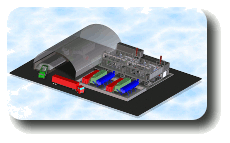Quick Info:
MIDI-plant

Scrap Tire Recycling









|
 |
 |
 |
 |
|
|
 |
| Dirk Gerlach Engineer
|
|
|
|
|
Dioxin Soil Cleaning in Spolana (CZ)
 |
Location: Spolana (CZ)
Typ: Master
Throughput: 7.000 kg/h
Dioxin contaminated soil
Startup 2005
Manufacturer: TechTrade (DGE)
DGE-function: mechanical design, mechanical startup
|
Wikipedia
Link to wikipedia-article
Press release: Neratovice, Czech Republic, 24th January, 2006
( This article was originally taken from www.sita.cz )
At a press briefing and tour held at the Spolana Chemical Works on Tuesday, 24th January, 2006, representatives of the companies responsible for the clean-up of the most contaminated areas of the works ("the Spolana Dioxin project"), namely the buildings A1420 and A1030 and the surrounding soil, announced that the construction of the process plant and installation of the remediation technology are now finished and the decontamination process will soon begin.
Management of the Spolana Dioxin Project is being handled by SITA CZ a.s. (ex SITA Bohemia a.s.) in collaboration with its technical partner, BCD CZ a.s.. BCD CZ a.s. is a joint venture between the technology and project orientated remediation company, TCSR from the United Kingdom, and SITA CZ a.s., the environmental branch of SUEZ, the French international industrial and services group.
Senior representatives of all companies involved in the project attended the press briefing, where Grahame Hamilton, the Chairman of BCD CZ a.s. and General Manager of TCSR, and Jean-Louis Chaussade, the CEO of SUEZ Environment, both talked in some detail about the remediation project. In explaining the relationship between the various companies and the Spolana project in particular, Grahame Hamilton said:
"The Spolana BCD plant is the largest constructed project of its type anywhere in the world. Since being awarded the contract to carry out the remediation process, our team has carried out intensive tests through a pilot plan that was implemented during 2003, and the construction of the infrastructure on site and the delivery of the relevant equipment began as early as summer 2005. Now that the construction is installed, we are in the process of testing the equipment with a view to the decontamination phase starting in May of this year.
What sets the Spolana project apart from other remediation projects, other than the degree of contamination and complexity of the project, is the willingness of the Czech government and Spolana itself to treat a seriously polluted and hazardous site to such safe levels and to provide flexibility of future end-use.
Today is a real milestone for everyone concerned, showing, as it does, the Czech Republic's willingness to deal with a major environmental burden from the past in a safe and professional manner, and, from our own personal point of view, demonstrating how an Anglo-French joint venture, together with a team of highly skilled Czech partners, can work towards a successful conclusion to something that, over the years, has been a major problem for the Czech Republic"
Jean-Louis Chaussade from SUEZ Environment added:
"The Spolana Project will place the Czech Republic as a European showcase in the field of decontamination. As with many other European countries, the Czech Republic faces the immense challenge of recovering from a heritage of heavy industry. Contaminated soil, left untreated, poses a long-term threat to the environment and the health of those who live and work on it. The Spolana project is a major environmental challenge for us as we prepare to treat 35000 tonnes of waste in 18 months.
"This is a historical time for Spolana, as it enters a new phase of life which will shake off the remnants of its damaging industrial past and face a cleaner, healthier future. We are very proud to be a part of this new era."
Contaminant concentrations at Spolana are some of the highest detected at any of the world's dioxin remediation sites and the project will be running until 2008, with full scale material processing starting in April/May of this year following extensive commissioning of the treatment plant components. In total, over 35,000 tonnes of highly contaminated materials (PCDD/F and OCP contamination) will be treated to levels of contamination measured in units of less than the decision of the regional office (for example, 0.2 nanograms per gram for contaminated soil). The materials being treated include waste residues and products from former manufacturing, the manufacturing plant and equipment, the structure that formed the plant building and over 23,000 tonnes of soils. (Such waste can be expected to include building rubble, chemicals, the metallic parts of the contaminated plant, dust and soils).
Health and safety during the clean-up will, of course, be paramount. All demolition, equipment removal, waste removal, material crushing and soil excavation will be conducted under a separate building enclosure operating with negative air pressure systems to prevent the spread of contamination to adjacent areas of the site and residential neighbours in the area. During the peak operation period, more than 160 people will be employed in the process, working a shift system to maintain 24 hour operation of the treatment plant.
The press briefing was followed by a visit to the Spolana Dioxin project by the Prime Minister Jiřà Paroubek, and the Minister for Environment, Libor Ambrozek, both of whom had the opportunity to see the BCD construction on site and to hear about the clean-up process that is to be undertaken. Both expressed their pleasure that the Spolana Dioxin clean-up is finally starting.
|
|
|
Dipl.-Ing.(FH) Dirk Gerlach • Passion for Innovation
|
|  |
 |
 |
 |
|
|
A Service of LEO GmbH.
|



















